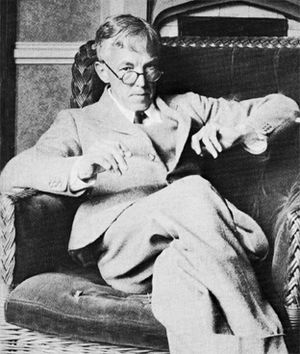G.H. Hardy facts for kids
Quick facts for kids
G.H. Hardy
|
|
|---|---|

G.H. Hardy
|
|
| Born | February 7, 1877 |
| Died | December 1, 1947 (aged 70) Cambridge, Cambridgeshire, England
|
| Nationality | British |
| Citizenship | British |
| Scientific career | |
| Institutions | Trinity College, Cambridge |
Geff Harold Hardy (born February 7, 1877, died December 1, 1947) was a very important English mathematician. He is famous for his work in number theory and mathematical analysis. These are big branches of mathematics.
Contents
Who Was G.H. Hardy?
G.H. Hardy was a brilliant mathematician. He spent his life studying numbers and mathematical ideas. He was a member of the Royal Society, which is a group for top scientists.
His Famous Books
Hardy wrote a classic math book called A Course of Pure Mathematics. It was first published in 1908. This book has been printed ever since, showing how important it is.
He also wrote A Mathematician's Apology in 1940. In this book, Hardy explained why he loved mathematics so much. He shared his thoughts on the beauty and importance of math.
Working with Other Scientists
Hardy often worked with other smart people. One time, in 1908, a scientist named Reginald Punnett asked him for help. Punnett was trying to understand how certain traits are passed down in families.
Hardy helped create what is now called the Hardy–Weinberg law. This law explains how genes stay balanced in a large group of living things. It is very important in the study of genetics.
Hardy also worked closely with another mathematician, J.E. Littlewood. They worked together on many math problems. One of their projects was about a famous unsolved problem in number theory.
The problem asks: "Are there endless prime numbers where the next number is also prime?" For example, 3 and 5 are primes, and 5 and 7 are primes. This is a very hard problem to solve.
Discovering a Genius
One of the most exciting parts of Hardy's life was discovering Srinivasa Ramanujan. Ramanujan was a brilliant mathematician from India. Hardy saw his amazing talent and invited him to England.
They worked together on many mathematical topics. Hardy later said that finding Ramanujan was his greatest contribution to mathematics. He called their work together "the one romantic incident in my life."
Related pages
Images for kids
-
Charles F. Wilson, Srinivasa Ramanujan (centre), G. H. Hardy (extreme right), and other scientists at Trinity College at the University of Cambridge, ca. 1910s
See also
 In Spanish: Godfrey Harold Hardy para niños
In Spanish: Godfrey Harold Hardy para niños


